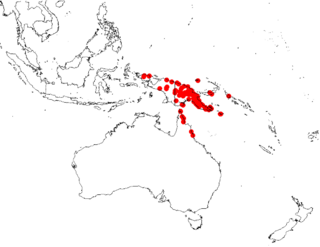
Walter Hood Fitch was a botanical illustrator, born in Glasgow, Scotland, who executed some 10,000 drawings for various publications. His work in colour lithograph, including 2700 illustrations for Curtis's Botanical Magazine, produced up to 200 plates per year.

Philippe Édouard Léon Van Tieghem was a French botanist born in Baillleul in the département of Nord. He was one of the best known French botanists of the latter nineteenth century.

Tristerix is a genus of mistletoe in the family Loranthaceae, native to the Andes, ranging from Colombia and Ecuador to Chile and Argentina. They are woody perennials usually occurring as aerial parasites, are pollinated by hummingbirds and flowerpiercers, with seed-dispersal generally by birds but occasionally by mammals (Dromiciops). The genus is distinguished from other New World Loranthaceae by its simple, terminal, racemose inflorescences, together with its of 4- or 5-merous flowers, versatile anthers, and the presence of endosperm. Further differences include fused cotyledons and the absence of epicortical roots.

Amyema miquelii, also known as box mistletoe, is a species of flowering plant, an epiphytic hemiparasitic plant of the family Loranthaceae, found attached to several species of Australian eucalypt and occasionally on some species of Acacia. It is the most widespread of the Australian Mistletoes, occurring mainly to the west of the Great Dividing Range. It has shiny leaves and red flowers arranged in groups of 3. It is distinguished from the similar Amyema pendula through the individual stalks of the flowers.

Amyema quandang is a species of hemi-parasitic shrub which is widespread throughout the mainland of Australia, especially arid inland regions, sometimes referred to as the grey mistletoe.

Amyema pendula, also known as drooping mistletoe or furry drooping mistletoe, is a species of flowering plant, an epiphytic hemiparasitic plant of the family Loranthaceae, found attached to several species of Australian eucalypt and occasionally on some species of Acacia. It is endemic to south-eastern Australia. It is the most common mistletoe in Victoria, especially on the coastal side of the Great Dividing Range. It has shiny leaves and red flowers arranged in groups of 3 or 4. It is distinguished from the similar Amyema miquelii through the lack of individual stalks on the flowers.

Decaisnina signata is a species of flowering plant, an epiphytic hemiparasitic plant of the family Loranthaceae native to Australia. It is found from Cape York to the Kimberleys.

Lysiana exocarpi, commonly known as harlequin mistletoe, is a species of hemiparasitic shrub, endemic to Australia. It is in the Gondwanan family Loranthaceae and is probably the most derived genus of that family with 12 pairs of chromosomes. The Loranthaceae is the most diverse family in the mistletoe group with over 900 species worldwide and including the best known species in Australia. Mistletoes are notable for their relationships with other species. In an early reference to the group in Australia Allan Cunningham explorer and first Director of the Royal Botanic Gardens, Sydney, wrote in 1817: "The Bastard Box is frequently much encumbered with the twining adhering Loranthus aurantiacus which 'Scorning the soil, aloft she springs, Shakes her red plumes and claps her golden wings'."

Amyema bifurcata is an epiphytic, flowering, hemiparasitic plant of the family Loranthaceae native to Australia and found in Western Australia, the Northern Territory, Queensland and New South Wales.

Amyema melaleucae, also known as the tea-tree mistletoe, is a species of flowering plant within the genus Amyema, an epiphytic hemiparasitic plant of the family Loranthaceae native to Australia and found in Western Australia and South Australia on the coast, from north of Perth almost to the Victorian border.

Decaisnina hollrungii is a species of flowering plant, an epiphytic hemiparasitic plant of the family Loranthaceae native to the New Guinea, Queensland, Australia, and in the Bismarck Archipelago and the Solomon Islands.

Amylotheca is a genus of hemi-parasitic aerial shrubs in the family Loranthaceae, found in Borneo, Malaysia, New Caledonia, New Guinea, Australia, Sumatra, Thailand, Vanuatu, and Philippines

Myosotis antarctica is a species of flowering plant in the family Boraginaceae, native to mainland New Zealand, Campbell Island and southern Chile. Joseph Dalton Hooker described the species in his 19th century work Flora Antarctica. Plants of this species of forget-me-not are perennial with a prostrate habit, bracteate inflorescences, and white or blue corollas. It is one of two native species of Myosotis in the New Zealand subantarctic islands, the other being M. capitata, which also has blue corollas.

Acaena microphylla, the bidibid or piripiri, and outside New Zealand, New Zealand-bur, is a small herbaceous, prostrate perennial flowering plant in the rose family Rosaceae, native to both the North and South Islands of New Zealand. There are two varieties:

Anisotome antipoda is a species of flowering plant in the family Apiaceae, which is endemic to the Auckland, Campbell and Antipodes Islands.

Azorella schizeilema is a species of cushion plant in the Apiaceae family, native to the Auckland and Campbell Islands.

Abrotanella rosulata is a plant in the family Asteraceae, endemic to the Campbell Islands.

Trilepidea is a extinct monotypic genus of flowering plants belonging to the family Loranthaceae. Its native range was New Zealand. The only species was Trilepidea adamsii, or Adams mistletoe. It was first described in 1880 as Loranthus adamsii and has ever only been collected from a few locations in the North Island. It has been argued that the extinction of this species, vulnerable due to restricted distribution, was caused by interaction of a number of factors, including introduction of an exotic species, in this case the brushtail possum from Australia.

Charles Samuel Pollock Parish (1822–1897) was an Anglo-Indian clergyman and botanist who served as chaplain to the forces of the Honourable East India Company in Burma. With his wife Eleanor he collected and painted plants, chiefly orchids, identifying and naming a number of species new to science. Several species are named in his honour.
Puccinellia stricta is a species of grass known by the common names Australian saltmarsh grass, and Marshgrass. It was first described by Joseph Dalton Hooker in 1853 as Glyceria stricta from a specimen collected at Akaroa, but was assigned to the genus, Puccinellia, in 1930 by Carl Hilding Blom. It is native to New Zealand and Australia, where it is found in Western Australia, South Australia, Victoria and Tasmania.




















